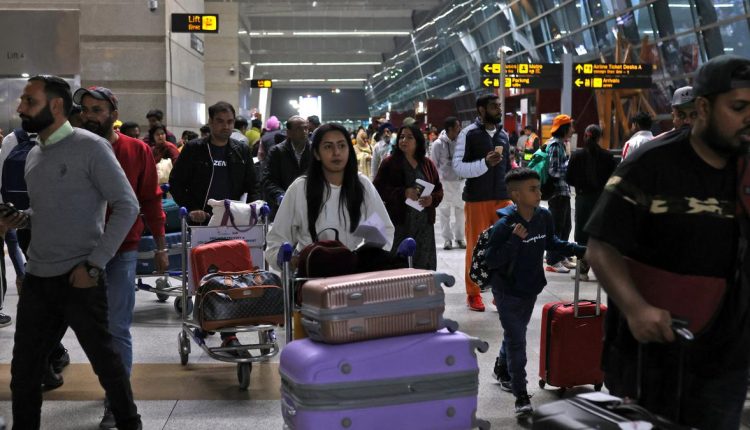Travellers push carts with their luggage at the departure area of Terminal 3 at Indira Gandhi International Airport in New Delhi on December 14, 2022.
| Photo Credit: Reuters
The story so far: Over the past few weeks, there have been delays and long queues at the Indira Gandhi International Airport in New Delhi, prompting Minister of Civil Aviation Jyotiraditya Scinda to step in to initiate corrective measures. A parliamentary panel summoned the CEO of Delhi International Airport Limited (DIAL), and the Airports Authority of India has issued a notice to examine whether it failed to meet “service quality requirements.”
What are the reasons for over-crowding?
Passengers have complained of long queues at entry gates, check-in counters as well as security lanes at the Indira Gandhi International Airport, with Terminal 3, built in 2010 to handle 3.4 crore passengers per annum, worst affected. So far December has witnessed a record number of air travellers since the COVID-19 outbreak with the highest number seen on December 11 when airlines carried 4.27 lakh domestic passengers. Delhi airport alone has seen 1,95,000 domestic and international passengers per day at all its three passenger terminal buildings.
According to a senior BCAS (Bureau of Civil Aviation Security) official, the number of flights and passengers at Delhi airport have grown exponentially, but its “infrastructure has frozen over time.” Equipment like X-ray machines and door frame metal detectors are bought by the airport out of its capital expenditure, while the CISF provides personnel and their cost is met through the aviation security fee component of airfare paid by passengers.
After Mr. Scindia visited the airport last week, a decision was taken to install seven more X-ray machines and take the number of total security lanes to 20 from the current 13, which were found to be adequate only for 15 flights, while the airport saw up to 21 flights during peak hours. A parliamentary panel also met DIAL officials, and the Airports Authority of India has also issued a notice to DIAL.
What are the service quality requirements?
The DIAL is supposed to submit a quarterly report on the “service quality requirements” spelt out in Schedule 3 of the Operations Management Development Agreement of 2006 under which certain functions at Delhi airport were privatised and given to the DIAL. The agreement specifies 13 different categories of services and the minimum time within which they should be available.
After the furore on overcrowding at Delhi Airport, the Airports Authority of India sent a notice to DIAL last week to examine whether it was failing to conform to the requirements. These include service parameters such as maximum queuing time; within two years of the deal, the airport has to ensure that for check-in the maximum waiting time is five minutes for business class and 20 minutes for economy. Similarly, for security check as well as customs, immigration and quarantine, as many as 95% of passengers should be cleared within 10 minutes. As far as baggage delivery is concerned, the first bag should arrive on the conveyor belt within 10 minutes, and the last bag should arrive within 30 minutes after the aircraft lands. The airport should also ensure wheelchairs for 100% of passengers who need them within five minutes.
There are other service parameters too, which include time taken to find parking space, maximum waiting time for taxis, and response to customer complaints on phone. If the airport operator fails to provide these standards, it is liable to pay 0.5% of the monthly revenue for every month that the standards are below the laid down requirements. A senior AAI official said so far the airport was able to meet these criteria.
Why has infrastructure not kept pace with the growth in demand?
COVID-19 turned the clock back as passenger traffic suddenly dropped to 56% to 6.3 crore in calendar year 2020. However, passenger numbers have been growing steadily since March this year after the fear of Omicron faded away. Moreover, with Diwali and Dussehra festivals in October, resurgence in demand was established. But expansion plans at various airports were put on the backburner due to the impact of COVID-19 on revenue as well as unavailability of manpower and material. Delhi airport embarked on an expansion plan that would take its passenger handling capacity from 6.9 crore now to 10 crore by mid-2023, but it is already a year behind schedule. Though this capacity will be breached in a couple of years, the National Capital Region will get its second airport in Noida International Airport in Jewar by 2024. The development of airports such as Mumbai and Chennai is also behind the growth curve.
Though the government has granted in-principle approval to 21 greenfield airport projects, construction has only begun in nine of them.


